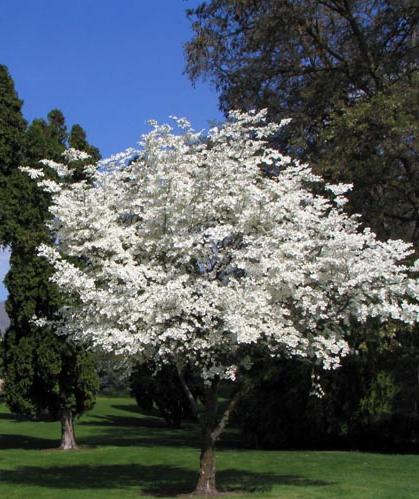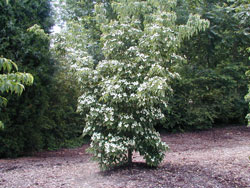Eastern Dogwood
Nothing is more a symbol of Spring’s arrival than the prolific blooming of the Eastern Dogwood. Unfortunately in recent years, Eastern Dogwood has been afflicted with an introduced pathogen which causes some trees to lose branches to the point they ultimately die. Trees in sunnier locations appear to do better with forest trees experiencing the worst declines.
Some evidence suggests that cultivars like Cherokee Princess are more tolerant but more research needs to be done. We recommend you consider using the Eastern Dogwood in your garden but keep in mind this issue.
Kousa Dogwood
This Asian beauty is increasingly being used in the American Landscape. One of the primary differences of the Kousa as opposed to the Eastern Dogwood is the timing of the bloom cycle. Eastern Dogwood blooms appear before the leaves whereas Kousa Dogwoods leaf first and then bloom. Kousas also have orange colored fruit in the Fall season providing another element of beauty to the landscape. Kousa Dogwood is resistant to the Dogwood pathogen. In hotter areas, Kousas appreciate a bit more shade but will adapt to full sun.
The American Dogwood is a favorite in landscapes all over the world. With it’s beautiful floral display in the Spring and smaller stature this is a great choice for smaller garden spaces. Fall foliage is a brilliant red followed by red berries which last into the Winter further elevating this plants desirability. Having been chosen by Virginia and North Carolina as their state flower, this plant has unfortunately been affected by an introduced pathogen from Asia.
Cultivars such as Cherokee Princess are believed to have a greater tolerance and planting in full sun seems to lessen the susceptibility as well.
Kousa Dogwood or the Asian Dogwood is used extensively in landscapes in the US and shows a resistance to the pathogen affecting the American Dogwood. It blooms late in the Spring with its flowers coming after the foliage appears. It exhibits a good amount of heat tolerance in Zones 7 and 8 but does seem to appreciate a bit of afternoon shade in the hotter climates.



